Монеты Кипра. Национальный дизайн. Cyprus coins
On 1 January 2008 Cyprus adopted the euro, the single european currency (1 euro = 0,585274 Cyprus pound). More than 310 million people in the 15 EU member states that have adopted the euro now share the benefits of the single currency.
The adoption of the euro will bring considerable benefits for the Cypriot citizen. Price transparency in the single market of the EU facilitates price comparability, fosters competition and leads to lower prices. The elimination of the exchange rate risk is conducive to trade transactions, thus also leading to lower prices. Travelling and buying goods and services in the euro area countries is easier, because citizens will not have the hassle of changing currencies every time they cross a border, and are better able to compare prices since they can use their own currency anywhere in the euro area. Travelling and buying goods and services outside the euro area is also easier, since the euro is an international currency and therefore widely accepted in many places outside the euro area, particularly in tourist destinations. Furthermore, both savers and investors can take advantage of increased opportunities for savings and investment, which emerge in the single financial market of the EU.
Moreover, there exist important potential benefits for the economy as a whole, such as price stability, sound public finances, low interest rates and a shield for negative shocks in the external environment. These conditions are conducive to bolstering economic growth, investment and employment, to the benefit of all citizens.
National Design of Cyprus Coin

The moufflon, the most characteristic species of Cyprus, representing the island's wild life.
It is depicted on the
1,
2 and
5 cent coins.

The ship of Kyrenia (4th century B.C.), representing Cyprus's character as an island as well as its history. Furthermore, it shows the island's importance in trade.
It is depicted on the
10,
20 and
50 cent coins.
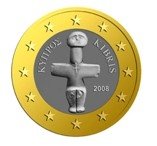
A cross-shaped idol dating back to the chalcolithic period (3.000 B.C.), from the village of Pomos. It is a characteristic example of the prehistoric art of Cyprus reflecting the island's civilization and antiquity.
It is depicted on the
1 and
2 euro coins.
Eurocoins specification:
1 CENT
Diameter (mm): 16.25
Thickness (mm): 1.36
Weight (g): 2.3
Shape: Round
Colour: Red
Composition: Copper-covered steel
Edge: Smooth
Design of New Common European Side

A geographical image of Europe in relation to Africa and Asia on a globe.
National Design of Cyprus Coin

The moufflon, the most characteristic species of Cyprus, representing the island's wild life.
2 CENT
Diameter (mm): 18.75
Thickness (mm): 1.36
Weight (g): 3
Shape: Round
Colour: Red
Composition: Copper-covered steel
Edge: Smooth with a groove
Design of New Common European Side
 National Design of Cyprus Coin
National Design of Cyprus Coin

The moufflon, the most characteristic species of Cyprus, representing the island's wild life.
5 CENT
Diameter (mm): 21.25
Thickness (mm): 1.36
Weight (g): 3.9
Shape: Round
Colour: Red
Composition: Copper-covered steel
Edge: Smooth
Design of New Common European Side
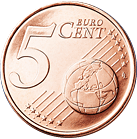 National Design of Cyprus Coin
National Design of Cyprus Coin

The moufflon, the most characteristic species of Cyprus, representing the island's wild life.
10 CENT
Diameter (mm): 19.75
Thickness (mm): 1.51
Weight (g): 4.1
Shape: Round
Colour: Yellow
Composition: Nordic gold
Edge: Shaped edge with fine scallops
Design of New Common European Side
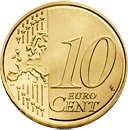 National Design of Cyprus Coin
National Design of Cyprus Coin

The ship of Kyrenia (4
th century B.C.), representing Cyprus's history and its character as an island as well as its importance in trade.
20 CENT
Diameter (mm): 22.25
Thickness (mm): 1.63
Weight (g): 5.7
Shape: Spanish flower shape
Colour: Yellow
Composition: Nordic gold
Edge: Plain
Design of New Common European Side
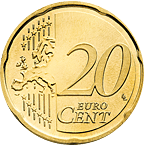 National Design of Cyprus Coin
National Design of Cyprus Coin
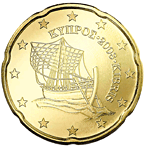
The ship of Kyrenia (4th century B.C.), representing Cyprus's history and its character as an island as well as its importance in trade.
50 CENT
Diameter (mm): 24.25
Thickness (mm): 1.88
Weight (g): 7.8
Shape: Round
Colour: Yellow
Composition: Nordic gold
Edge: Shaped edge with fine scallops
Common European Side
 National Design of Cyprus Coin
National Design of Cyprus Coin

The ship of Kyrenia (4
th century B.C.), representing Cyprus's history and its character as an island as well as its importance in trade.
1 EURO
Diameter (mm): 23.25
Thickness (mm): 2.125
Weight (g): 7.5
Shape: Round
Colour: External part: yellow; internal part: white
Composition: Nickel brass; three-layer
Edge: Interrupted milled
Design of New Common European Side
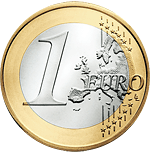
A geographical image of Europe as of 1 January 2007.
National Design of Cyprus Coin

A cross-shaped idol dating back to the chalcolithic period (3.000 B.C.), found in Pomos, a village in the district of Paphos. It is a characteristic example of prehistoric art in Cyprus, reflecting the island's antiquity and civilization.
2 EURO
Diameter (mm): 25.75
Thickness (mm): 1.95
Weight (g): 8.5
Shape: Round
Colour: External part: white; internal part: yellow
Composition: Copper-nickel; three-layer: nickel brass, nickel, nickel brass
Edge: Edge lettering, fine milled
Design of New Common European Side
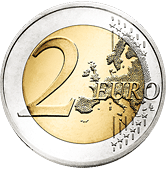
A geographical image of Europe as of 1 January 2007.
National Design of Cyprus Coin

A cross-shaped idol dating back to the chalcolithic period (3.000 B.C.), found in Pomos, a village in the district of Paphos. It is a characteristic example of prehistoric art in Cyprus, reflecting the island's antiquity and civilization.



















 CY +357-96-38-39-40
CY +357-96-38-39-40
 RU +7 965 2 38-39-40
RU +7 965 2 38-39-40
 UA +38-073-738-39-40
UA +38-073-738-39-40
 WhatsApp
WhatsApp
 Messenger
Messenger
 Сообщение
Сообщение
 info@24glo.com
info@24glo.com